CONTACT & STAFF
Facility E-mail: paineira@lnls.br
Coordination: Cristiane B. Rodella
Tel.: +55 19 3512 1040
E-mail: cristiane.rodella@lnls.br
Click here for more information on this Facility team.
Paineira beamline is dedicated to X-ray diffraction studies of polycrystalline materials (PXRD) housed within Sirius at the Brazilian Synchrotron Light Laboratory (LNLS). This facility will offer PXRD data collections in high resolution mode, with angular resolution estimated at 0.008º FWHM. In addition, the beamline also provides in situ and operando measurements for kinetic experiments with rapid 2D detectors, covering large angular ranges. The whole PXRD data is estimated to be acquired in seconds. The beamline hosts numerous states of the art automation processes to aid users to rapidly collect high quality data. This includes automated sample exchanges using robotics, multiple sample environments (samples holders for various types of samples, various reaction cells, devices, and accessories) and sample environments covering in-situ and operando experiments for functional materials.
The beamline is temporarily operating with a wiggler from the UVX as the X-ray source, meanwhile an undulator is in fabrication. The undulator will provide the X-ray source with a photon flux of 1013 ph/s/0.1% bw/100 mA (@15 keV) ensuring the collection of rapid, high quality diffraction patterns. It will be delivered and installed in mid 2024.
The beamline energy is fixed at 19.5keV until the commissioning of the monochromator is finished late in 2023. Then, the beamline will operate in the energy range of 5 to 30 keV (2.48 – 0.41Å) allowing for the transmission geometry experiments of high Z elements or to allow for anomalous diffraction. The flexibility of the beamline also allows for easy tuning of the photon energy to avoid fluorescence from absorption edges of chemical elements with the sample to increase data quality.
Paineira uses a Newport Heavy-Duty 3-circle diffractometer operating in Debye-Scherrer geometry (transmission or capillary geometry). Two sets of detectors are available on the diffractometer. For high resolution experiments, a set of Multi-Analyzer Crystals (MAC) will be employed. For rapid data acquisitions, a 2D arc-shaped detector (PiMega 450D).
Debye-Scherrer geometry is ideal for finely ground powder samples housed within capillaries. However, polycrystalline pellets and films may also be analyzed using the wide variety of sample holders available to users. The beamline will cover a variety of experimental cases covering fields such as, but not limited to, materials science, pharmaceuticals, catalysis, devices for energy storage and capture, such as batteries and supercapacitors, multiferroic ceramics, and environmental sciences (geoscience).
Facility E-mail: paineira@lnls.br
Coordination: Cristiane B. Rodella
Tel.: +55 19 3512 1040
E-mail: cristiane.rodella@lnls.br
Click here for more information on this Facility team.
⚠ Paineira beamline will receive proposals from external users in the next call (August 2023). Granted proposals with beamtime will be executed between October 2024 and March 2025.
The beamline will operate at an energy between 5 – 20keV (wavelength between 2.4796Å – 0.6199Å), with high-resolution detection (FWHM of ~ 0.008°, ~4h for data acquisition) and fast detection (FWHM of ~0.07°, ~2 min for data acquisition). A standard PXRD analysis at room temperature or temperatures ranging from -180°C to 300°C will be acquired in high-throughput mode operation. In situ XRD analysis using the capillary reactor will be possible but with some restrictions in this period. A controlled flow of inert gases, such as N2 e He, and synthetic air and some gas mixtures, such as 3%H2/He; 4%CH4/He and 20%CO2/He. In addition to temperature variation from 25 °C to 850 °C, at ambient pressure. The flow of steam and liquids, such as water at ambient pressure, will also be possible.
Please consult the beamline staff before sending your proposal, especially if temperature variation is required for the high-throughput mode or in situ XRD analysis is the focus of the proposal. Email: paineira@lnls.br
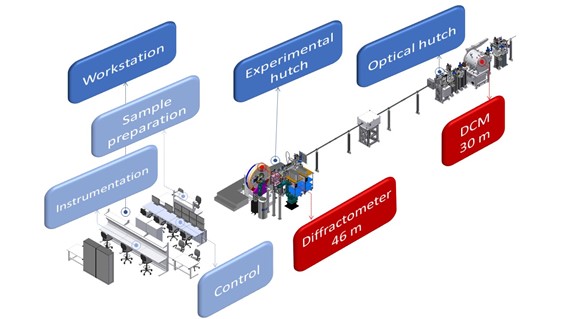
| Element | Type | Position [m] | Description |
|---|---|---|---|
| Source | Insertion device | Wiggler 1T (temporary source) | |
| White beam slit | Slit | 27.9 | Determination of beam divergence |
| Beam diagnostics | Diagnosis | 28.2 | Visualization and diagnosis of the white beam |
| Double crystal monochromator | Bruker Monochromator | 30.0 | Monochromatization |
| Beam diagnostics | 32.0 | Monochrome beam visualization and diagnosis | |
| Monochrome beam slit | 43.4 | Monochrome beam slit | |
| Beam diagnostics | 43.4 | Initial intensity counter (I0) | |
| X-ray attenuator | 44.8 | Beam attenuator | |
| Robotic arm | GP25 – Motoman | 45.2 | Sample room changer |
| In situ design control module | Development in house | 45.5 | Gas flow control and design control |
| Diffractometer | Heavy-Duty, 3-circles | 46.0 | Sample alignment with incident beam and diffracted beam detectors |
| Detection system | MAC – Oxford FMB | 46.0 | Set of 8 independent analyzer crystals with ~2° 2θ separation of scintillating detectors (FMB-Oxford) |
| Detection system | ARCPIX (in-house development) | 46.0 | Fast arc-shaped detector with 100° angular coverage |
| Robotic arm | GP8 – Motoman | 46.5 | Sample changer |
| Sample Magazine | Development in house | 47.0 | Sample storage carousel where GP8 robot will transfer sample |
| X-ray beam visualization | X-ray and photodiode eyes | 47.5 | Transmitted beam viewer |
| Parameter | Value | Condition |
|---|---|---|
| Energy range | 5 – 20 keV 14 – 30 keV |
Si(111) Si(311) |
| Flux at sample [ph/s] | ~1013 | 15 keV |
| Energy resolution (ΔE/E) | ~10-4 | 15 keV |
| Angular resolution (MAC) | 0.008° | FWHM @ 15 keV |
| Angular range in 2θ (MAC) | 3 – 145° | |
| Angular resolution (Pimega 450D) | 0.05° | (all energies) |
| Angular range at 2θ (Pimega 450D) | 3° – 100° | |
| Beam dimensions [mm x mm] | 1.1 (v) x 1.7 (h) | FWHM @ 15 keV |
| Beam divergence [μrad] | 25 (v) x 37 (h) | FWHM @ 15 keV |
In addition to the experimental hutch, the PAINEIRA beamline has a room for sample manipulation (Figure 1), with direct access to the experimental hutch, through a second door to facilitate the arrival of samples to the diffractometer. Connected to this room is the control room of the beamline, where the user operates the beamline, processes the acquired data, and visualizes all the experimental parameters of the experiment. Finally, the beamline has an instrumentation room.
The experimental station has been designed to optimize the amount of synchrotron light users have access to during their beamtime. To provide fast data acquisition with various experimental setups, the diffractometer (Figure 2.1), uses two sets of fixed detectors (Fig. 2.2 and Fig. 2.3) with automated sample exchange via a sample magazine (Fig. 2.4) with robotics dedicated to automated and autonomous sample exchange. (Fig. 2.5).
Robotics and automation for the operation and use of thermal blowers for experiments ( cryojet or gas blower – Fig. 2.6) will further aid in providing a rapidly exchangeable experimental platform for various types of experiments (Fig. 2.7). When the beamline is operated in high-throughput mode, the beamline becomes fully autonomous, easily controlled remotely, or left to measure and screen wide ranges of samples with ease and speed. When gas or liquid flow is required, an automated, fixed in-line control module aids the user to easily change the reaction environment to simulate real world conditions (Fig. 2.8). Finally, to study chemical reactions, mass spectrometer analyzers (Fig. 2.9) and (Fig. 2.10) micro gas chromatographs are available and connectable to the diffractometer’s reactors.
To meet the demand to conduct cutting edge research, the two types of detectors can be used consecutively and prioritized to work with the required instrumentation for ex situ experiments, as well as in situ and operando.
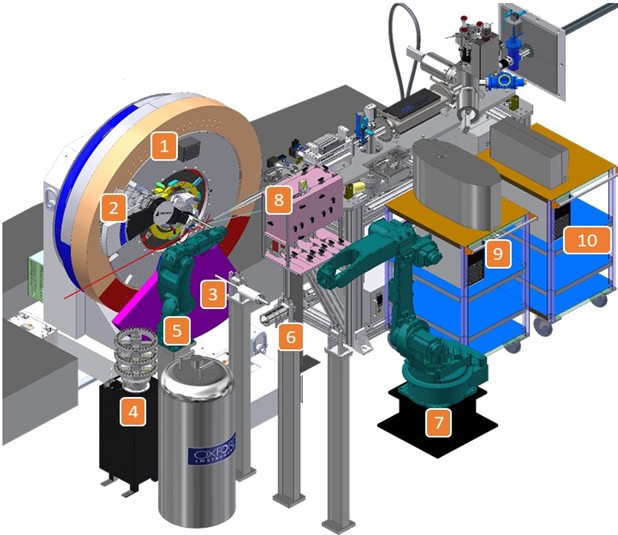
Figure 2. Design of the Paineira beamline experimental station: 1) Newport Heavy-Duty 3-circle diffractometer; 2) High resolution detector; 3) fast arc detector spanning 109° in 2 θ ; 4) Sample magazine with 320 capillary capacity; 5) Robotic arm for automated exchange; 6) Supports for the cryojet and hot air blower to be used for cooling and heating the samples; 7) Robotic arm to place the cryojet or hot air blower at the sample position during experiments; 8) Gas flow control module and in situ and operando experimental control module; 9) Mass spectrometer; and 10) Micro GC.
Paineira provides sample holders, reaction cells and analytical equipment for measurements to cover a wide range of experimental conditions. In addition, the Paineira group will continue developing new instrumentation for in situ and operando experiments for the scientific user.
The table below shows systems that have already been developed and are available at beamline in operation. It is strongly recommended to contact the beamline staff to check the availability and flexibility of the instrumentation. Moreover, new sample environment development will be welcomed.
Figure 3: Sample holder, cell and accessories for X-ray diffraction experiments of polycrystals in PAINEIRA.
High-resolution mode features a system of 8 Si analyzer crystals (111), aligned in front of point scintillating detectors (Fig. 3). The X-ray beam diffracted by the sample passes through the analyzer crystals set at the appropriate Bragg angle. The angle is the Darwin width of the Si(111) crystal only allows diffracted x-rays satisfying the Bragg condition to be detected. For example, at 15 keV with an analyzing crystal of Si(111), the Darwin width is approximately 3.55 arcsec. This high-resolution setup will produce highly resolved diffraction peaks while removing background as well as florescence signals for improved signal to noise ratios. Diffraction peaks with full width at half maximum (FWHM) of the order of 0.008° at 2θ will be resolvable. However, this detection mode with point-to-point collection requires relatively longer data collection times. Scans covering a 2θ angular range from 5-100° at 15 keV will take around 1 hour to complete.
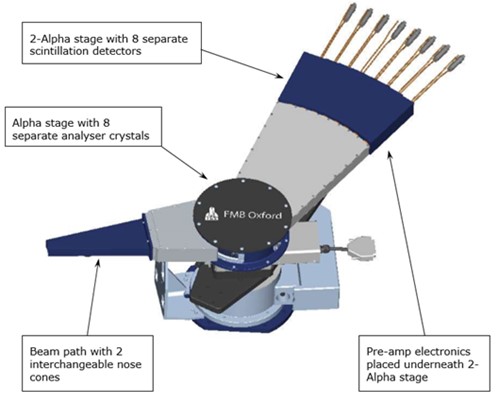
Figure 3. The FMB-Oxford MAC system for high-resolution experiments.
The fast acquisition, medium resolution detector (0.07° FWHM resolution) is an internal development of the LNLS detector group in partnership with Pi-Tecnologia. The Pimega 450D is a detection system based on Medipix3RX ASIC detectors, arranged in a 2D arc shape with wide angular coverage and installed on the delta circle of the diffractometer, as indicated in Fig. 2.3). This mode of data collection will optimize measurement time where rapid data collection is required while ensuring good data quality and resolution. The setup aims to meet the requirements of scientific cases that require rapid detection when a sample is undergoing structural transformation and required high temporal resolution (seconds/pattern) and/or has sensitivity to X-ray exposure to reduce sample damage induced by the beam.
The Pimega 450D contains 10 modules, with 2 Si elements each, installed in an arc around the delta circle of the diffractometer. Each Si element (Medipix3RX ASIC) uses a 256 x 1550 pixel chip with each pixel 55 μm x 55 μm placed 89 cm from the sample resulting in an angular resolution of 0.05° (FWHM). The read rate will be up to 1000 frames per second. The detector will cover a large angular 2θ range from 0 to 100°, with entire diffraction patterns collected in a matter of seconds. As it is a 2D detector (256 pixels x 30,060 pixels), an azimuthal integration will be performed for each measurement to transform the image of the X-ray diffraction pattern into an Intensity versus 2θ plot. Furthermore, to improve the collection statistics the detector will swivel between two positions to cover any gaps between each detector module. Thus, two individual measurements with offset of the circle delta will be added to produce a single continuous diffractogram and a software will make the superimposition and necessary corrections for the result (graph Intensity vs 2θ) to be quickly visualized by the user.
Debye-Scherrer geometry works ideally using a powdered sample inserted into capillary tubes. The available capillaries (materials and capillary diameters) are presented in Table 1. It is noteworthy that the kapton capillaries will be used for Paineira’s high-throughput operating system. Borosilicate and quartz capillaries will be used in the capillary cell.
Table 1. Sample holders available in the Paineira beamline and their specifications.
Calculation of sample absorption as a function of composition, packing density (~0.6 for powder samples and ~1 for volumetric bodies), capillary diameter (or thickness of volumetric sample) and wavelength can easily be done using the following online calculator. To allow for optimized signal in transmission geometry, the X-ray absorption coefficient must be calculated to assist in selecting the energy of the experiment (19.5keV) and the thickness of the capillary (or of the sample, in the case of the flat-plate).
https://11bm.xray.aps.anl.gov/absorb/absorb.php
In cases where it is necessary to decrease the absorption coefficient, the packing density can be decreased by mixing the sample with a low-density, amorphous material. If you have any questions regarding sample preparation and experimental conditions, please do not hesitate to contact the beamline team for assistance.
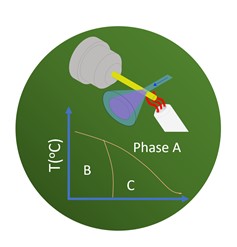
The development of new materials has contributed to the search for novel solutions to the worlds technological, environmental and health problems. In this case, to design and control physical properties of materials, it is vital to understand structure in both ambient conditions, as well as a function of temperature. Measurements such as these allow for better understanding of synthesis methods or analysis of phase transitions and construction of phase diagrams for example.
Here, X-ray diffraction with automatic sample change can be used as a function of composition to analyze the crystalline phases and distinguish between polymorphic phases at room temperature. Or, when interesting, to know the behavior of crystal structures as a function of temperature.
Paineira will make it possible to combine different angular, temporal and temperature ranges resolutions. The results of these crystal structure thermal dependence experiments reveal the behavior of the crystal structure, the existence of phase transitions, as well as the order of the transition (first or second order) and its character (displacive or order-disorder). These results, correlated with the thermal dependence of physical properties (dielectric, magnetic, thermal, elastic, optical analysis, among others) are fundamental for the control and operation of these new materials and for the proposal of new technologies.
The structural properties of functional materials, such as catalysts, change depending on the variation of reaction parameters (fluid type, temperature, and time, for example), as well as application conditions. Thus, it is of great importance that the studies of the physical and chemical properties of these materials are carried out under in-situ conditions (control of one or more reaction parameters) and, if possible, the operation (operating) should be characterized under conditions. Thus, at Paineira it will be possible to install a reaction cell, called a capillary, where the sample will be deposited. The cell will allow controlled flow of gas, liquid, or both and with ambient pressure variation up to 80 bar. It will also be possible to pass a controlled flow of steam at ambient pressure and heat the sample to 800 ºC at controlled rates and/or temperature thresholds. The references below report studies of this type that will be possible in the Sirius Paineira beamline.
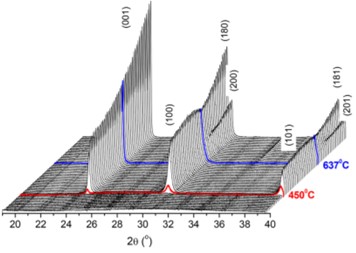
Glauco F. Leal, Dean H. Barrett, Heloise Carrer, Santiago J. A. Figueroa, Erico Teixeira-Neto, Antonio Aprigio S. Curvelo, Cristiane B. Rodella. J. Phys. Chem. C, 2019, 123, 5, 3130–3143. DOI: 10.1021/acs.jpcc.8b09177
The structural properties of electrocatalysts are directly related to the performance, lifetime and charge cycles of energy storage devices such as batteries and supercapacitors. Electrocalyzers are generally metals and/or transition metal oxides that are normally dispersed in carbon and form the cathode of these devices. Structural changes, as well as the formation of crystalline by-products during the loading and unloading processes of the devices, occur during their operation. Therefore, these make up more examples of scientific cases where PXRD measurements need to be collected during the operation of these devices. Thus, Paineira will also develop electrochemical cells and cells supports to be installed in the light line and connected to a potentiostat. Thus, allowing the detection of structural changes of polycrystalline materials from these energy storage devices, as shown in the references below:
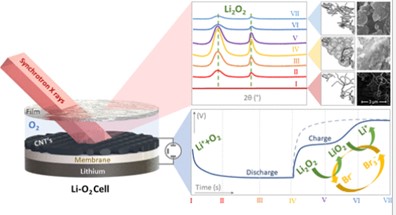
Leticia F. Cremasco, Chayene G. Anchieta, Thayane C. M. Nepel, André N. Miranda, Bianca P. Sousa, Cristiane B. Rodella, Rubens M. Filho, Gustavo Doubek. ACS Appl. Mater. Interfaces 2021, 13, 11, 13123–13131. DOI: 10.1021/acsami.0c21791

Bruno Morandi Pires, Willian Gonçalves Nunes, Bruno Guilherme Freitas, Francisca Elenice Rodrigues Oliveira, Vera Katic, Cristiane Barbieri Rodella, Leonardo Morais Da Silva, Hudson Zanin. Journal of Energy Chemistry Volume 54, March 2021, Pages 53-62. DOI: 10.1016/j.jechem.2020.05.045